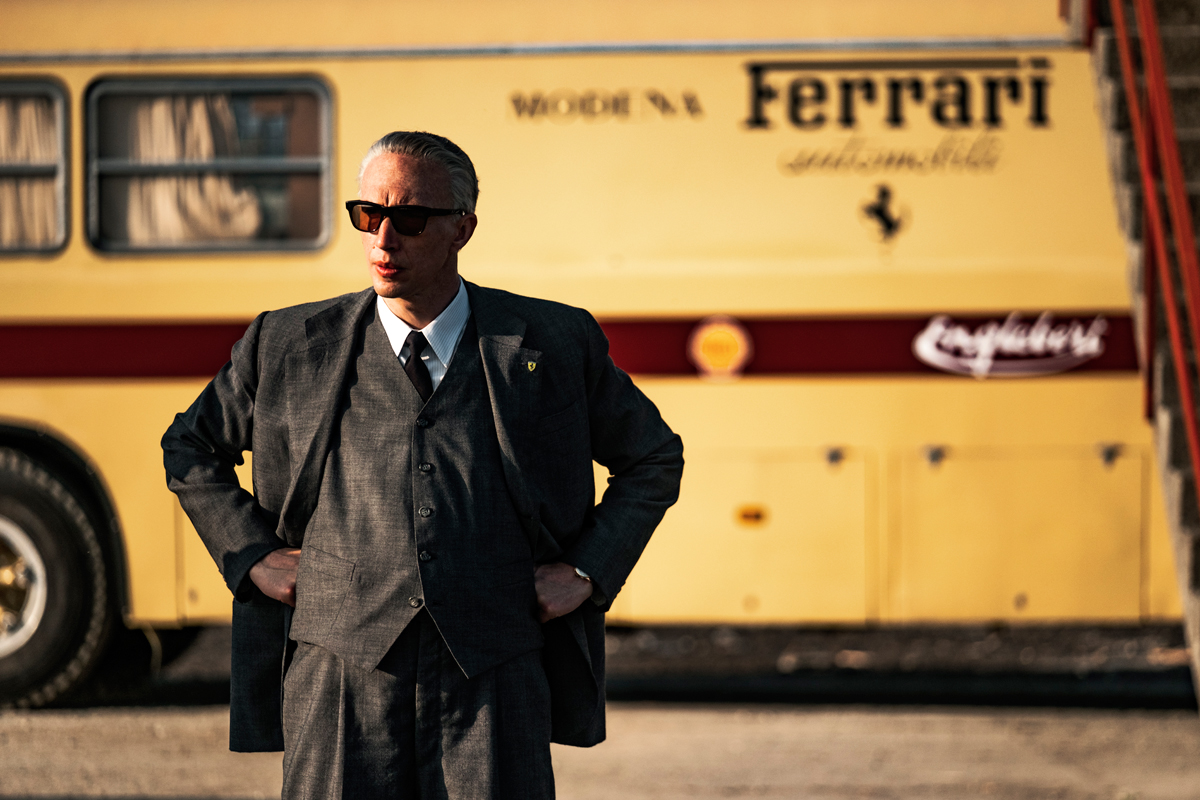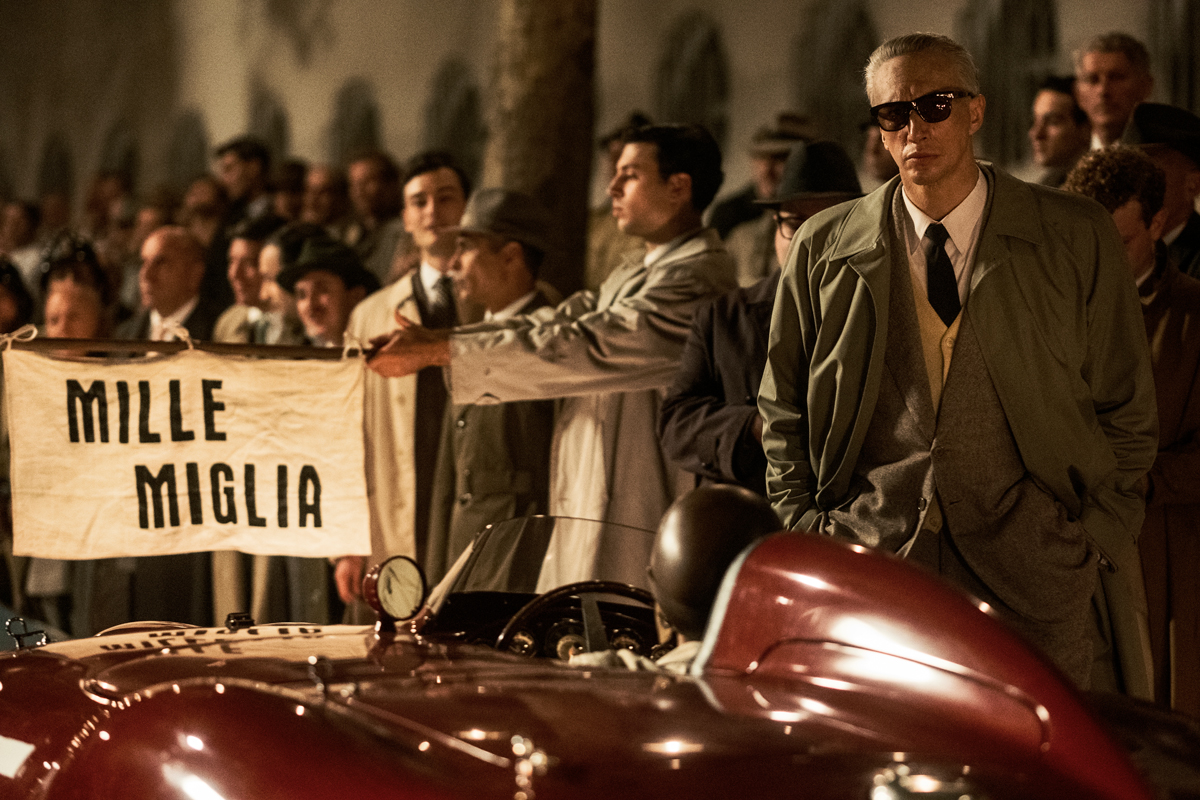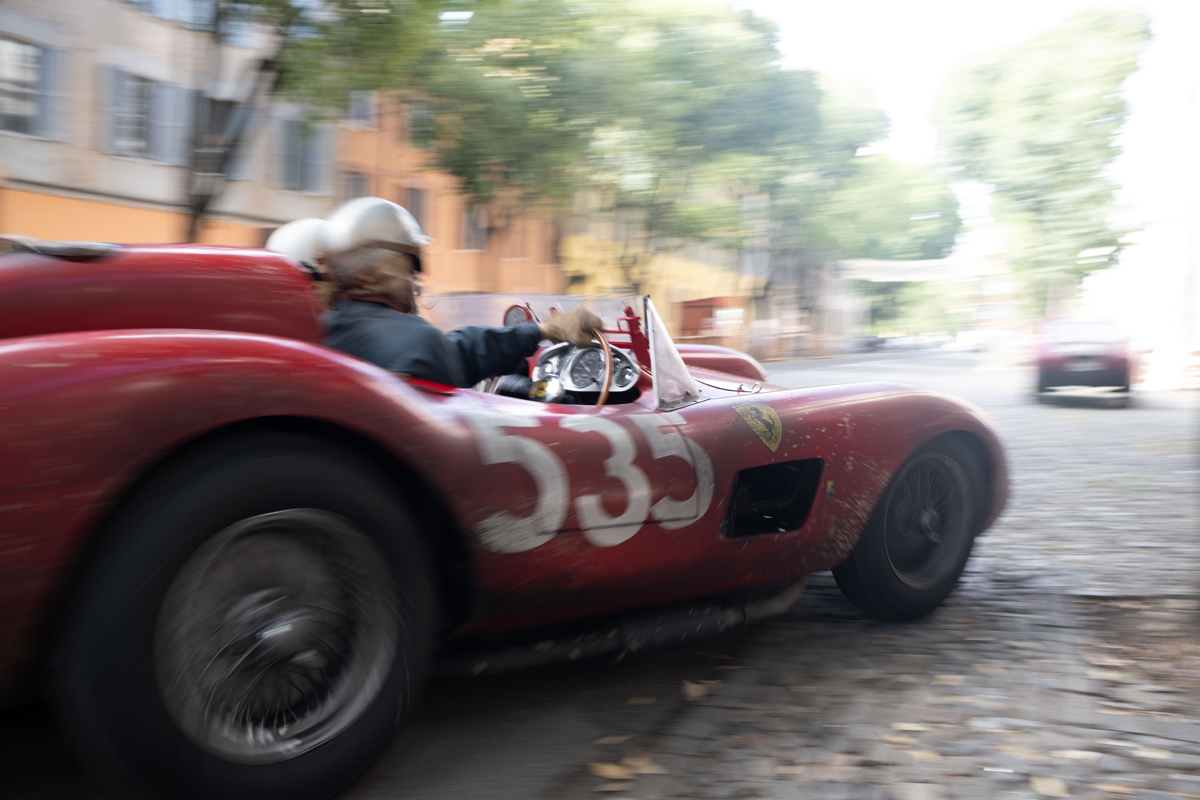 Leo Goldsmith
Leo Goldsmith
In a biopic of Enzo Ferrari, Michael Mann focuses on deals, details, and destruction on the racetrack.

Adam Driver as Enzo Ferrari in Ferrari. Courtesy Neon. Photo: Lorenzo Sisti.
Ferrari, directed by Michael Mann, opens in theaters December 25, 2023
• • •
In the third-season opener of Miami Vice, Detective Sonny Crockett’s black 1972 Ferrari 365 GTS/4 Daytona Spyder—an important accessory for the character’s cover as a high-end drug dealer and malefactor, and a key component of the series’ aesthetic—is destroyed by a rocket launcher fired by Jeff Fahey’s bayou-dwelling arms dealer. There was a reason for this profligate gesture beyond its utility as a display of ’80s consumerism and action spectacle: the Daytonas used in the show (there were two of them) were replicas, built on the chassis of Corvettes. The story that the show’s executive producer Michael Mann tells is that Enzo Ferrari himself—then nearly ninety—saw the fake Ferraris and was furious, insisting that the show use the real deal and gifting the production with two of the latest model. And so, at the start of the next episode, the Metro-Dade Police Department supplies Crockett with a replacement: a 1986 Testarossa in cocaine white.

Adam Driver as Enzo Ferrari in Ferrari. Courtesy Neon. Photo: Lorenzo Sisti.
Michael Mann has been fetishizing and destroying Ferraris for four decades now. Probably no other single individual—apart from Enzo himself—is more responsible for Ferrari’s brand recognition in the public consciousness, making him the ideal filmmaker to tackle a movie that bears the marque’s name. That Mann’s film arrives in the year of the feature-length sponcon—alongside Barbie, Air, BlackBerry, and Flamin’ Hot—suggests a degree of corporate-cinematic synergy. But Ferrari is something both more classical and more idiosyncratic than those: a focused 124-minute portrait (practically a vignette in an era of wafty three-plus-hour epics) that eschews Freudian origin stories in favor of the chaotic, inexorable present-tense of its subject, his company, and his clan.

Daniela Piperno, left, as Adalgisa Ferrari and Penélope Cruz, center, as Laura Ferrari in Ferrari. Courtesy Neon. Photo: Lorenzo Sisti.
Set in 1957, the film tracks Ferrari’s restless movements around his home province of Modena. Throughout, Enzo (played by Adam Driver) ping-pongs between the church, the factory, the opera, and the racetrack, and between the apartment he shares with his semi-estranged wife and business partner, Laura (a deliciously brooding Penélope Cruz), and the rustic estate where he’s set up his mistress, Lina Lardi (Shailene Woodley), and their illegitimate son. As he juggles familial obligations and dodges the predatory tabloid press, Ferrari is also building his motorsport racing team, for which he is pushing his company to the brink of insolvency and his drivers to their premature—and grisly—demise. (At the start of the film, his star driver Eugenio Castellotti hits a curb on the Modena Autodromo and is flung a hundred yards to his death.) Facing the imminent collapse of his business, his marriage, and maybe even his extramarital relationship, Enzo doggedly pursues the one feat that might save him: winning the Mille Miglia, an infamous thousand-mile endurance race held on open roads from Brescia to Rome and back.

Adam Driver as Enzo Ferrari in Ferrari. Courtesy Neon. Photo: Lorenzo Sisti.
True to form, Mann approaches this material with an obsessive attention to detail to match Il Commendatore and his team’s “brutal determination to win.” The Ferraris themselves—the cars, that is, not the people—were hand-built from 3D scans of the original models, and the races (and especially the crashes) are meticulously re-created in all their gruesome particulars. The Modena of the late 1950s, including every last detail of wardrobe and setting, is simulated with a similar fussiness: from Enzo’s uniform black shades and immaculate gray suits down to the gothic bizarrerie of Laura’s wallpaper. It’s a similar fealty to historical precision that Mann brought to previous period pieces like The Insider and Ali, one that’s sometimes so conspicuous as to feel almost uncanny.

Still from Ferrari. Courtesy Neon. Photo: Eros Hoagland.
On the one hand, a fixation on automotive and period accuracy; on the other, Adam Driver, a curious choice for the title role. With his Kylo Ren intensity and wry humor, Driver brings plenty of Mann-ly tenacity to the character and can pivot effortlessly to Ferrari’s more easygoing side, instructing his child about the beauty of engine design or engaging in a little casual macho ball-busting with the guys at the track. But Driver looks very little like Enzo Ferrari in 1957, who was then a full two decades older than the actor and lacked his Superman shoulders. Worse, Driver delivers the film’s often exposition-freighted dialogue—penned by Italian Job scribe Troy Kennedy Martin—with the same tortured accent-work he honed in Ridley Scott’s 2021 camp curio House of Gucci. It took me two viewings of Mann’s film before I realized that Driver’s strained pronunciations sounded more like Triumph the Insult Comic Dog than a true paesano. (“I haff beezness!”) But casting big-name stars is how movies are made these days. (Or, rather, financed—the film’s credits list no fewer than twenty-eight executive producers, including Driver.)

Penélope Cruz as Laura Ferrari in Ferrari. Courtesy Neon. Photo: Lorenzo Sisti.
Fortunately, in Cruz’s Laura Ferrari, the film has a genuine movie star. (Maybe the title really refers to the missus?) Almodóvarian that she is, Cruz brings the right degree of outsize melodrama while inflecting her portrayal with surprising wordless nuances. The contrast between the two performances is evident early in the film, when Enzo and Laura take turns visiting the grave of their dead son: Driver blusters and fake-cries; Cruz staggers in grimly and then gradually, tearily, roguishly grins—a minute, complex, and entirely unexpected evocation of grief. Whether she’s out shopping, trading glares with Mamma Ferrari (Daniela Piperno), scheming retribution against Enzo, or dressing down some bank clerk, Laura haunts the film with a dark volatility, lockjawed under a disheveled black mop. Her energy befits a movie with operatic aspirations and does the heavy lifting in its fascinating inverted love triangle, in which Cruz plays the enigmatic, seductive wife opposite Woodley’s stay-at-home mistress. Mann’s films are, of course, famously centered on their single-minded male ciphers, but they also spotlight a somewhat less heralded collection of performances by women: Tuesday Weld in Thief, Joan Allen in Manhunter, Gong Li in Miami Vice, Viola Davis in Blackhat, and the superb ensemble of Diane Venora, Amy Brenneman, and Ashley Judd in the consummate movie-for-guys-who-like-movies, Heat. The director is not exactly a Bechdel scholar, and much is made of his penchant for male melodrama—but Cruz’s performance makes a strong case for the contributions of the women of Mann.

Still from Ferrari. Courtesy Neon. Photo: Eros Hoagland.
For Mann, though, the action is the juice. Ferrari derives its propulsion from its punctilious, violent, and LOUD racing sequences: from Castellotti’s brutal exit at the start of the film (his body flung from his vehicle like an empty beer bottle) to the horrific climax of the Mille Miglia (an event canceled for good after the 1957 edition because of the driver and civilian mortality rate). Cinematographer Erik Messerschmidt assembles these scenes with gliding tracking shots, sinister dolly-zooms, and delirious whip-pans, while Pietro Scalia’s editing uses early cinema–style crosscutting to invest them with a sense of genuine dread—every shot of a turn in the road or an irregularity in the pavement foreshadowing another corpse smeared across the asphalt. When the inevitable occurs, it arrives in a splash of CGI carnage and metal. It’s enough to make you contemplate giving up driving entirely—but Mann doesn’t let you dwell on this thought. Immediately, Ferrari speeds ahead: there are more races to be run, deals to be made, and cars to be built and destroyed.
Leo Goldsmith is a writer, teacher, and curator based in Brooklyn.